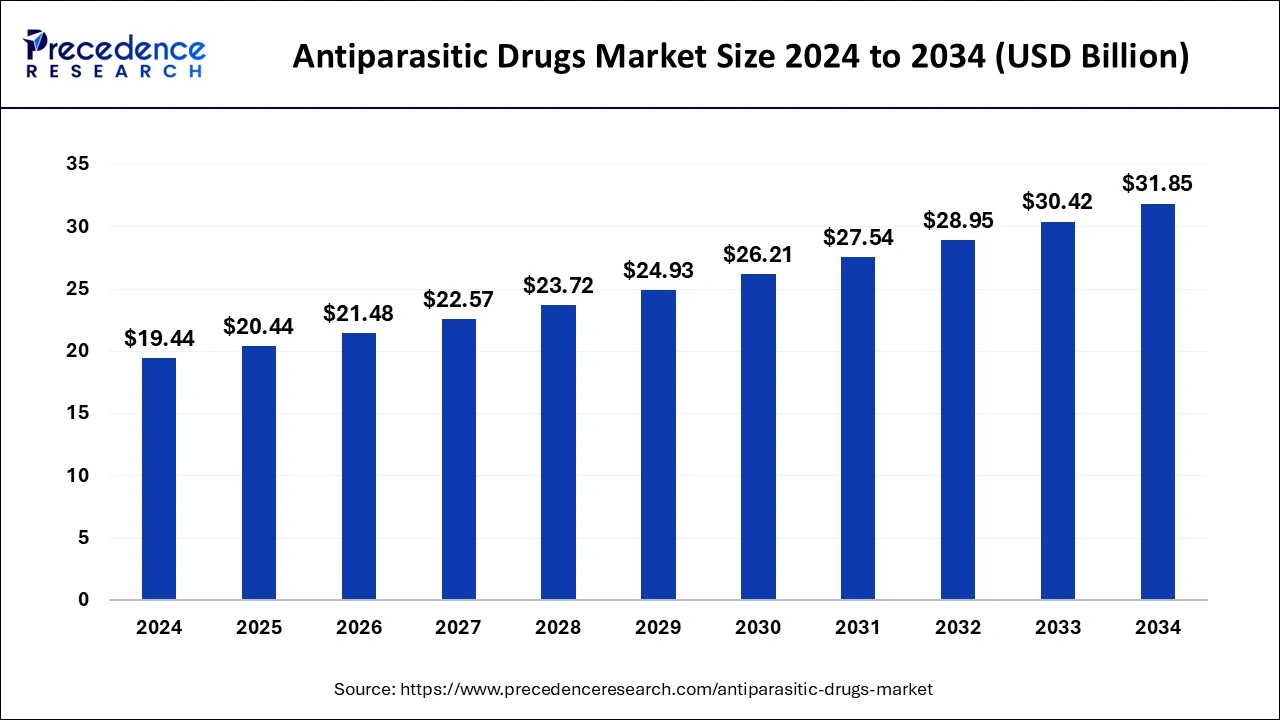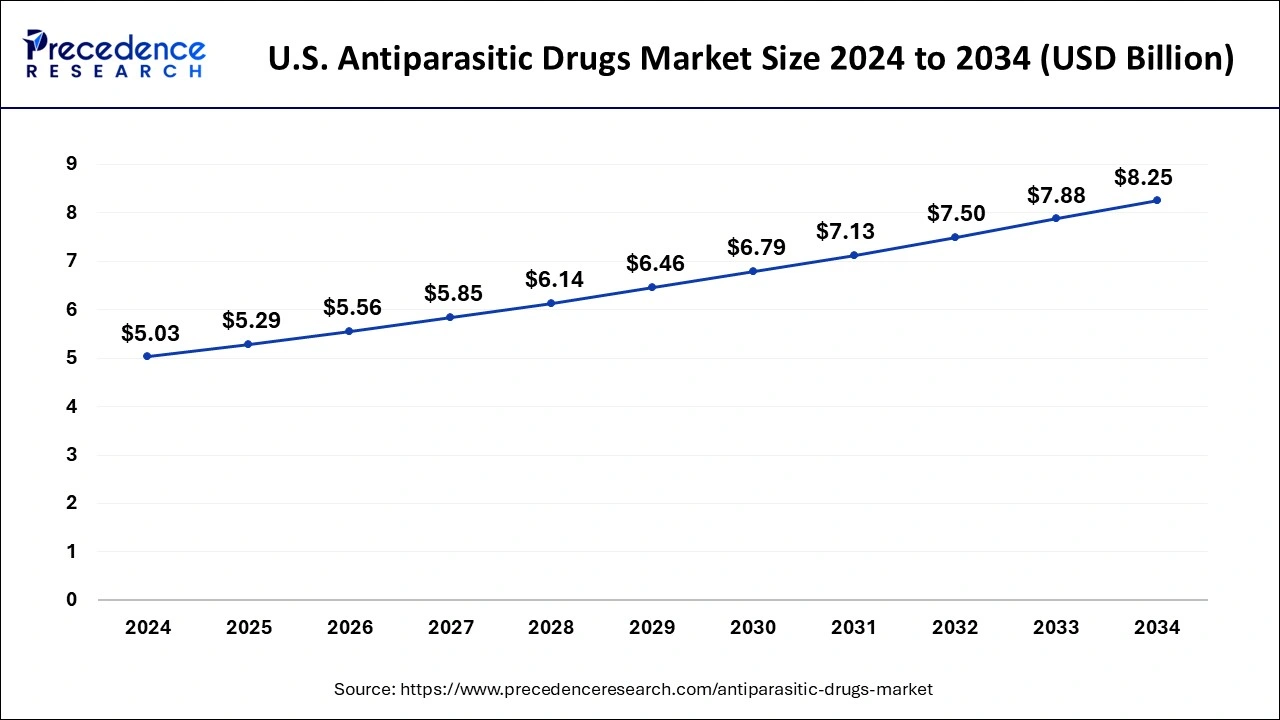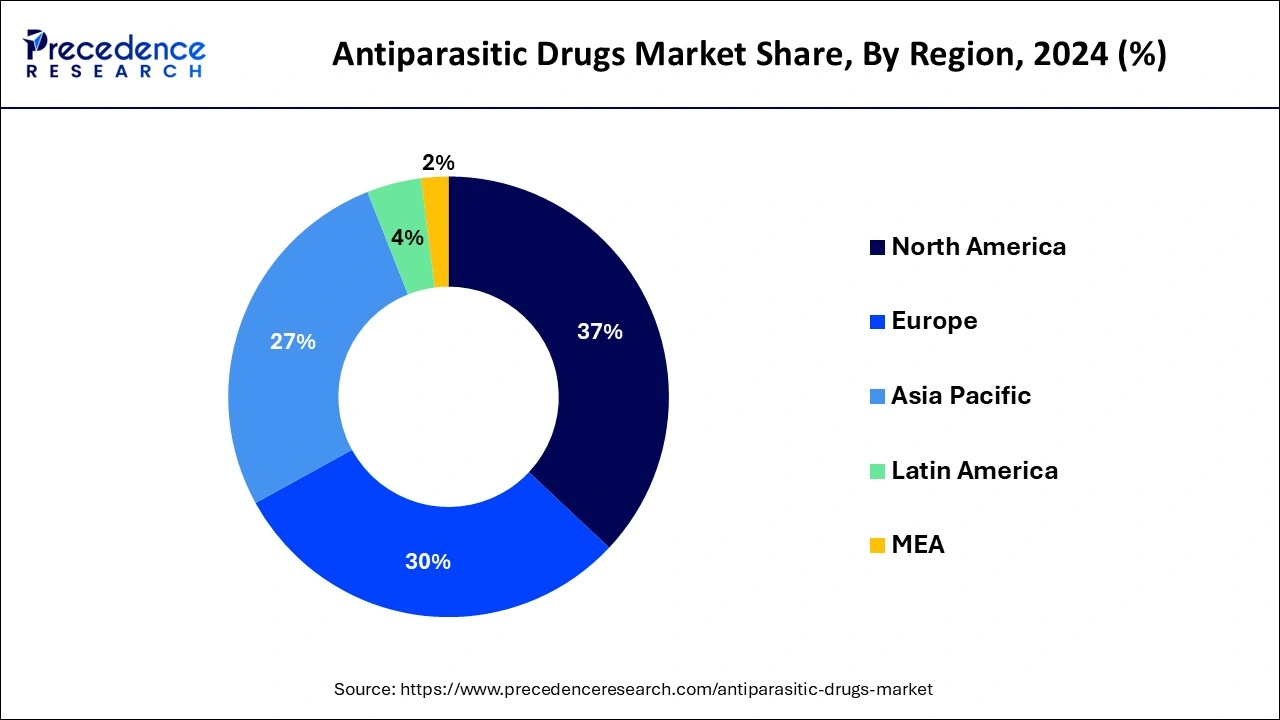Antiparasitic Drugs Market Size and Forecast 2025 to 2034
The global antiparasitic drugs market size was estimated at USD 19.44 billion in 2024 and is predicted to increase from USD 20.44 billion in 2025 to approximately USD 31.85 billion by 2034, expanding at a CAGR of 5.06% from 2025 to 2034. The increasing cases of parasite infections such as malaria, toxoplasmosis, etc002E, by the environment, impaired quality of water, bug bites, etc., are driving the growth of the antiparasitic drugs market.

Antiparasitic Drugs Market Key Takeaways
- In terms of revenue, the global antiparasitic drugs market was valued at USD 19.44 billion in 2024.
- It is projected to reach USD 31.85 billion by 2034.
- The market is expected to grow at a CAGR of 5.06% from 2025 to 2034.
- North America dominated the market with the largest market share of 37% in 2024.
- Asia Pacific is expected to witness the fastest expansion rate in the antiparasitic drugs market during the forecast period.
- By drug type, the anthelmintics drug segment dominated the market in 2024.
- By drug type, the antiprotozoal drug segment is expected to grow at the fastest rate during the forecast period.
- By route of administration, the injectable segment held the largest share of the market in 2024.
- By distribution channel, the hospital pharmacies segment dominated the market in 2024.
- By distribution channel, the retail pharmacies segment is expected to witness the fastest growth rate during the forecast period.
U.S. Antiparasitic Drugs Market Size and Growth 2025 to 2034
The U.S. antiparasitic drugs market size was valued at USD 5.03 billion in 2024 and is anticipated to reach around USD 8.25 billion by 2034, poised to grow at a CAGR of 5.09% from 2025 to 2034.

North America dominated the antiparasitic drugs market with the largest market share of 37% in 2024. The growth of the market is owing to the rising awareness about health among the people, and the rising healthcare infrastructure is boosting the growth of the market. The increasing investments in the development of healthcare infrastructure and the well-established pharmaceutical industry are accelerating the growth of the antiparasitic drugs market. The increasing R&D and the launch of innovative videos are driving the demand for the market.

Asia Pacific is expected to witness significant growth in the antiparasitic drugs market during the forecast period. The growth of the market is owing to the developing healthcare infrastructure and the pharmaceutical industries in countries like China, India, and Japan, which are boosting the growth of the market. The ongoing technological development in the pharmaceutical industry and the launch of innovative medicines are boosting the growth of the antiparasitic drugs market in the region.
Market Overview
The antiparasitic drugs market offers therapeutics that are prescribed to treat infections caused by parasites. The microscopic creatures known as parasites, which reside on or inside humans and animals, cause many illnesses. Antiparasitic medications come in a wide variety. Every medicine specifically targets a parasite. The illnesses they treat can have mild to severe symptoms. Throughout the world, parasites are the source of billions of infections. Parasitic infections come in a variety of forms. Malaria is among the most widespread parasite illnesses. Periodically, gastroenteritis (stomach flu) can be brought on by parasites.
The global expansion of parasitic illnesses has been attributed to greater migration and international travel. The antiparasitic medicine industry is expected to benefit from expanding R&D activity as well as an increase in company collaborations aimed at the growth of the market during the forecast period.
Antiparasitic Drugs Market Growth Factors
- The increase in cases of parasite infections like helminthiasis and malaria is affecting the number of people in the tropical and subtropical regions and is driving the growth of the antiparasitic drugs market.
- The rising R&D activities and the increasing investment in the pharmaceutical industries for the development of new antiparasitic drugs are contributing to the growth of the market.
- The global surge in the healthcare and pharmaceutical sector is driving drug development and the launch of the latest medication, which accelerates the growth of the market.
- The government's supportive regulation and initiatives for the medication of infectious diseases, vaccination programs, and health awareness programs held by the authorities are driving the market's growth.
Market Scope
| Report Coverage | Details |
| Growth Rate from 2025 to 2034 | CAGR of 5.06% |
| Market Size in 2024 | USD 19.44 Billion |
| Market Size by 2034 | USD 31.85 Billion |
| Largest Market | North America |
| Base Year | 2024 |
| Forecast Period | 2025 to 2034 |
| Segments Covered | By Drug Type, By Route of Administration, and By Distribution Channel |
| Regions Covered | North America, Europe, Asia-Pacific, Latin America, and Middle East & Africa |
Antiparasitic Drugs Market Dynamics
Driver
Increasing parasitic infection
The ongoing spread of parasitic infections due to viral disease transmission, environment, contaminated food, bug bites, water, eating undercooked food, etc., has caused a substantial demand for therapeutic solutions. The parasite infection causes fatigue, fever, skin rashes, itchiness, intestinal symptoms, and neurological symptoms. Malaria, toxoplasmosis, head ice, giardiasis, and pinworms are the most common parasite infections that can be found in the human body. Each parasite infection has a different kind of treatment and dosage. Antiparasitic drugs work by limiting the growth of parasites and killing parasites or their eggs. Thus, the rising environmental changes, eating habits, and other reasons for the spread of infections are driving the demand for the antiparasitic drugs market.
Restraint
Regulatory policies and side effects associated with drug use
Regulatory policies exercise restrictive control on the antiparasitic drugs market. They influence several aspects of the drug development process. The rigid approval process mandated by regulatory bodies retard the product development and manufacturing process dockets while simultaneously adding to the retail prices, generating intimidating barricades to market entry. Another aspect of market retardation is a lack of awareness of antiparasitic drugs in rural and underdeveloped economies, and the side effects of the drugs, in some cases, are limiting the growth of the antiparasitic drugs market.
- In 2022, The World Organization for Animal Health provided a document, “Responsible and Prudent Use of Anthelmintic Chemicals to Help Control Anthelmintic Resistance in Grazing Livestock Species”.
Opportunity
Increasing research and development
The rising investments by the government, research centers, pharmaceutical firms, and private investors in the research and development program for the development of antiparasitic drugs are driving the opportunity for the growth of the market. Increasing collaboration with the major market firms for the development of the medical drugs market is anticipated to drive the growth of the antiparasitic drugs market.
Drug Type Insights
The anthelmintic drug segment dominated the antiparasitic drugs market in 2024. The growth of the segment is attributed to the rising infection of the helminthic in low and medium-income countries, boosting the demand for the segment in the anthelmintic drug market. The helminths are divided into three groups- cestodes, nematodes, and trematodes, which are also known as tapeworms, roundworms, and flukes respectively. Helmintics differ from infectious organisms. There are various drugs used for the treatment of worm infections. Most of the drugs are administered orally and used in both human and veterinary medicines. The increasing cases of helminth in low- and middle-income countries are driving the demand for anthelmintic drugs in the market.
The antiprotozoal drug segment is expected to grow at the fastest rate in the market during the forecast period. The rising cases of protozoal infection and diseases like malaria, toxoplasmosis, and leishmaniasis drive the demand for the segment in the market. Antiprotozoal drugs are strictly prescription medicines and can be available in various forms of dosage like capsules and tablets, and also available in the forms of powder for prepared as an injectable solution.
Route of Administration Insights
The injectable segment projected higher growth in the market in 2024. The growth of the segment is attributed to the higher efficiency of drugs due to the administration of drugs via injections, which is driving the growth of the segment in the market. Injectable administration directly allows the drug to be delivered to the bloodstream and shows the rapid results of the drug. Injectable administration is a direct fight against the infection-causing bacteria in the body due to its direct administration of drugs into the bloodstream. Thus, all these factors are driving the growth of the segment in the market.
The topical segment is expected to grow in the market during the anticipated period. The topical administration of drugs means the medicines are directly applied to the infected skin or hair. Most of the parasites are impacted by the infection on the skin, causing rashes and itchiness. Thus, topical administration is given relief in such kinds of conditions. All these factors are boosting the growth of the segment in the antiparasitic drugs market.
Distribution Channel Insights
The hospital pharmacies segment dominated the antiparasitic drugs market in 2024. The growth of the segment is attributed to the rising availability of medical professionals, infrastructure, and the handling of injectables administered antiparasitic, which is effectively driving the growth of the segment in the market. Hospital pharmacies, having medical expertise and a higher availability of drugs and hospital staff to look after the patients, accelerate the growth of the hospital pharmacies segment.
The retail pharmacies segment is expected to grow at the fastest pace during the predicted period. The growth of the segment has increased due to the rising cases of first aid drugs or medicines for treatment by the nearby retail pharmacies, which is boosting the demand for the antiparasitic drugs market in the retail pharmacies.
Antiparasitic Drugs Market Companies
- GlaxoSmithKline plc
- Merck KGaA
- Novartis AG
- F. Hoffmann-La Roche Ltd
Recent Developments
- In January 2024, Pfizer and Glenmark collaborated to launch Abrocitinib, the first advanced oral systematic treatment for mild to severe atopic dermatitis in India. Abrocitinib was developed by Pfizer and received the Central Drugs Standard Control Organization's permission to market in India.
- In January 2024, researchers found the monthly course of antimalarial combination drug dihydroartemisinin–piperaquine added to the daily routine of the antibiotic co-trimoxazole minimizes the risk of malaria by 68% in pregnant-HIV positive women. In the study, it is seen that about 1 million HIV-positive pregnant women are also suffering from malaria in Sub-Saharan Africa.
- In June 2022, Lyndra Therapeutics dosed the first participant in its Phase I clinical trial investigating oral biweekly ivermectin (LYN-163) to fight malaria.
- In March 2022, May & Baker Nigeria PLC launched a new drug, Artelum Combo, to combat malaria parasites across the country. The medicine is a one-of-a-kind combination of Arthemeter Lumefantrine and Paracetamol that provides complete malaria therapy in a single package.
- In 2023, Naveen Kumar Reddy Chinnappanna et al., published by Sciendo. The protein kinases, choline transport inhibitors, dihydroorotate dehydrogenase inhibitors, isoprenoid biosynthesis inhibitors. Recent approaches in the drug research and development of novel antimalarial drugs with new targets.
Segments Covered in the Report
By Drug Type
- Anthelmintic
- Antiprotozoal
By Route of Administration
- Oral
- Injectable
- Topical
By Distribution Channel
- Hospital Pharmacies
- Retail Pharmacies
By Geography
- North America
- Europe
- Asia-Pacific
- Latin America
- Middle East and Africa
For inquiries regarding discounts, bulk purchases, or customization requests, please contact us at sales@precedenceresearch.com
Frequently Asked Questions
Ask For Sample
No cookie-cutter, only authentic analysis – take the 1st step to become a Precedence Research client
 sales@precedenceresearch.com
sales@precedenceresearch.com
 +1 804-441-9344
+1 804-441-9344